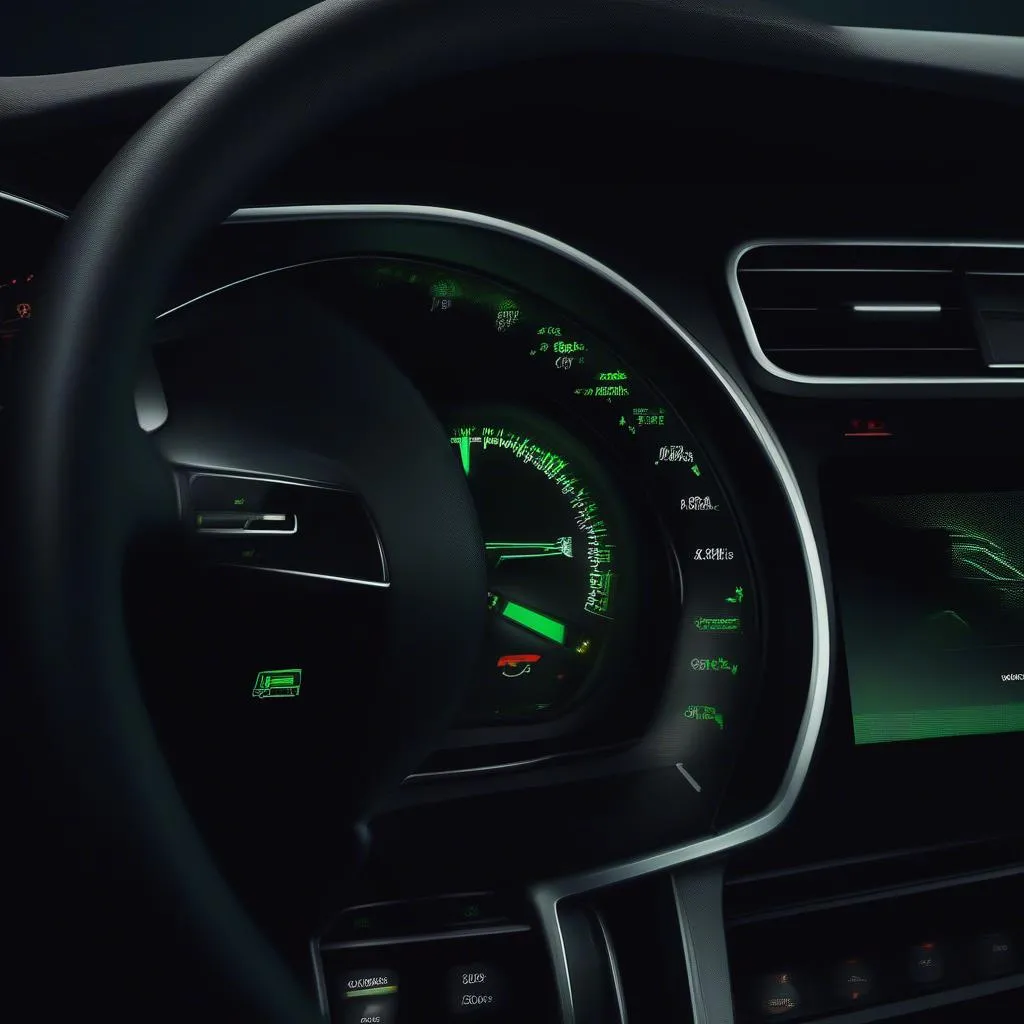Imagine you’re cruising down the picturesque Angeles Crest Highway in your sleek Audi A4. The California sun is setting, painting the sky in hues of orange and purple. Suddenly, a light on your dashboard you’ve never noticed before illuminates – a car icon pointing downwards. What does it mean? Is something wrong with your car? Don’t worry, you’re not alone. This is the “Downhill Car Light,” and it’s more common than you might think, especially in European cars like Audi, BMW, and Mercedes-Benz.
Unpacking the Downhill Car Light
What Does “Downhill Car Light” Actually Mean?
While the name might seem a bit obvious, the “downhill car light,” also known as the “Hill Descent Control” light, isn’t just about going downhill. It’s a signal that your vehicle’s Hill Descent Control system is activated. This system is designed to assist drivers in safely navigating steep declines, particularly on slippery or uneven terrain.
“The Hill Descent Control system is a testament to how car manufacturers are continuously innovating to provide safer driving experiences,” says John Miller, a seasoned automotive engineer from Michigan. “It takes the stress out of driving downhill, allowing drivers to focus on steering.”
When Does the Downhill Car Light Turn On?
The downhill car light typically illuminates when certain conditions are met:
- You’re driving down a steep slope: Most systems require a minimum grade of around 15-20% for activation.
- Your speed is below a certain threshold: This varies between manufacturers, but it’s usually around 20 mph.
- You’ve engaged the Hill Descent Control feature: This is usually done by pressing a button located on the center console or dashboard.
 Audi Hill Descent Control
Audi Hill Descent Control
Why is the Downhill Car Light Important?
Enhanced Safety on Downhill Drives:
The primary purpose of the Hill Descent Control system is to enhance safety. It does this by automatically controlling your vehicle’s speed and braking on steep descents, preventing acceleration and minimizing the risk of skidding or loss of control.
This feature is particularly useful when:
- Driving on icy or snowy roads: Hill Descent Control helps maintain traction on slippery surfaces, reducing the chance of sliding.
- Towing a trailer: The system assists in controlling the descent, preventing the trailer from pushing or swaying.
- Navigating off-road trails: Hill Descent Control provides added control and stability on uneven terrain.
Understanding the Limitations:
While the Hill Descent Control system is a valuable safety feature, it’s crucial to remember that it’s not a substitute for safe driving practices. Always be aware of your surroundings, adjust your speed to the conditions, and maintain a safe following distance.
“Drivers should view Hill Descent Control as an assistive technology, not an autopilot,” warns automotive expert Sarah Jenkins, author of “The Complete Guide to Car Safety Systems.” “Over-reliance on such features can lead to complacency and potentially dangerous situations.”
Troubleshooting a Malfunctioning Downhill Car Light
If your downhill car light illuminates unexpectedly or fails to turn on when needed, it could indicate an issue with the system. This could be due to a faulty sensor, a software glitch, or a mechanical problem.
Here’s what you can do:
- Consult Your Owner’s Manual: Your vehicle’s owner’s manual will provide specific information about the Hill Descent Control system and any warning lights associated with it.
- Check for Error Messages: Some vehicles display error messages on the dashboard if there’s a problem with the system.
- Visit a Qualified Mechanic: If you suspect an issue, it’s best to take your vehicle to a qualified mechanic specializing in your car’s make and model. They can diagnose the problem using a dealer scanner for European cars and perform any necessary repairs.
 Mechanic Diagnosing Car Problem
Mechanic Diagnosing Car Problem
Related Queries About the Downhill Car Light
Here are some frequently asked questions about the downhill car light:
- Can I turn off Hill Descent Control while driving downhill? Yes, you can usually deactivate the system by pressing the Hill Descent Control button again or pressing the accelerator pedal firmly.
- Does Hill Descent Control work in reverse? Some vehicles offer a Hill Hold Control feature that prevents rollback when starting on an incline, but Hill Descent Control generally only works when driving forward.
- Is Hill Descent Control standard on all cars? No, it’s typically found on SUVs, trucks, and some cars with off-road capabilities.
Need Help with Your Car’s Diagnostics?
At Tech Car USA, we understand the importance of a safe and reliable vehicle. If you’re experiencing issues with your car’s electronics, including your Hill Descent Control system, our team of expert technicians is here to help. We specialize in European car diagnostics and offer a wide range of services to keep your vehicle running smoothly. Contact us on Whatsapp at +84767531508 for expert assistance and to schedule an appointment.
Explore More Car Tech Insights:
- Can I put my car in neutral without starting it? Link to article: https://techcarusa.com/can-i-put-my-car-in-neutral-without-starting-it/
- Understanding the intricacies of car accident investigation Link to article: https://techcarusa.com/car-accident-investigation/
Have more questions about car technology? Leave a comment below, and our team of experts will be happy to assist you! Don’t forget to share this article with your fellow car enthusiasts and help demystify the world of automotive technology.